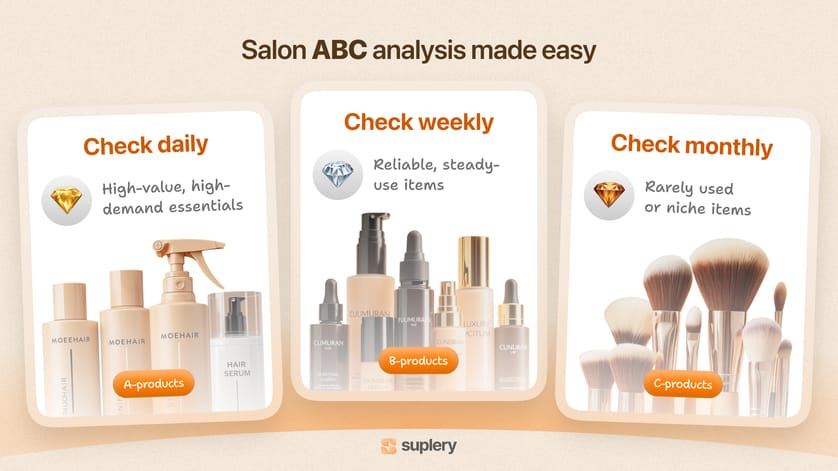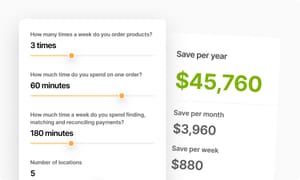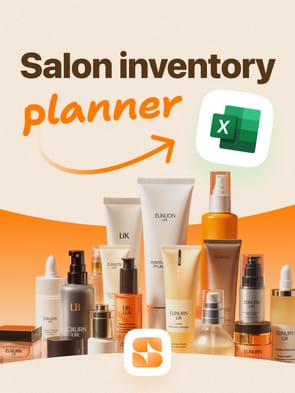Cut inventory costs in salon: save on salon inventory & optimize stock
Ask most salon managers about their biggest budget killers, and you’ll usually hear the usual suspects: rent, payroll, or those high-end product lines. But want to know the sneaky expense quietly burning through your salon’s monthly expenses? Messy inventory management.
And no, it’s not just about running low on shampoo or drowning in extra hair masks. It’s the quiet drip-drip of waste, mysterious shrinkage, lost sales opportunities, and cash that’s stuck gathering dust on the shelves. Here’s a wake-up call: 50% of salons still tracking manually face monthly inventory shortages — and a whopping 80% of salon owners admit that solid inventory management is absolutely crucial to their successful salon.
Yet, somehow, salon inventory remains one of the salon industry’s most neglected — and costly — blind spots.
Here’s the juicy part: salons that finally ditch outdated methods and embrace smarter, modern inventory management strategies pocket as much as $5,000 extra each year, boosting profit margins by a healthy 10–15%. That’s real cash — cash you can reinvest in advanced training, upgraded salon equipment, or simply enjoying some well-deserved peace of mind to improve financial stability.
In this article, I’m pulling back the curtain to show you exactly how inventory inefficiencies are secretly bleeding your salon business dry — and handing you practical cost-saving strategies to stop the leak. Whether you’re running a salon— a cozy solo suite or steering a bustling multi-chair space — let’s tackle this overlooked expense head-on to save money and increase profits.
Make it easy with our inventory planning tool
Simplify your salon inventory instantly with our ready-to-use Excel planner: set clear reorder points, accurate quantities, smart buffers, and easily track products.
Oh no! We couldn’t subscribe you ☹️
Done! We've sent a link to your Email 📨
Perfect for hair salons, nail salons, beauty clinics, or solo suites — say goodbye to guesswork, and hello to smooth, budget-friendly inventory management system with just a few clicks.
Decode demand: track your inventory like a pro and stop losing cash
If you’re serious about fixing your stock issues and reducing operational costs, you’ve got to decode exactly how your products are moving. Before you can cut inventory costs in salon and plug leaks, you need total clarity: what’s coming in, what’s flying off shelves, and what’s vanishing mysteriously. And let’s get real — your intuition isn’t enough. Even industry veterans (myself included) can’t manage a backbar packed with hundreds of salon products by memory alone.
Here are three razor-sharp strategies to get your inventory tracking game on point for effective inventory management:
Weekly stock check: keep your finger on the pulse
Pick one consistent day each week for a focused visual check and quick count of your top-moving retail products and backbar essentials. You’ll quickly spot what’s always running low or what’s collecting dust. Whether it’s your color tubes or lash adhesives, doing this weekly transforms chaos into clear patterns, aligning with market trends and customer preferences.
Immediate write-off: crack open, record it, done
This tip is pure gold. Don’t wait until bottles hit empty — write off products the second they’re opened. That’s when their true inventory life begins, impacting their average shelf life. Smart salon cost control means knowing when items become actively usable, not just when they disappear forever, to cut unnecessary costs.
Service-level precision: measure every drop
Take your inventory tracking to the next level by logging exactly how much inventory each service consumes. Whether it’s 0.5 oz of developer or 1.5 fl oz of massage oil, knowing your precise usage unlocks accurate service pricing, sharper profit margins, and smarter restocking to maximize profits.
Now, let’s keep it real: meticulously tracking every single item isn’t always feasible. At the mid-sized Boston hair salon I managed, we regularly stocked over 1,000 SKUs across retail products, backbar, and specialized treatments. Daily monitoring each one? Not a chance.
That’s exactly why savvy salon owners leverage ABC analysis — a smarter way to prioritize and conquer salon inventory chaos, ensuring product availability and customer satisfaction.
Simplify stock tracking with ABC analysis — your salon’s new best friend
ABC analysis is your secret weapon for effortlessly sorting salon products into clear, manageable categories based on value or frequency of use, supporting effective inventory management:
- A-products: Your superstar items — high-value, high-demand essentials (hair color, lash adhesive, top-selling shampoos).
- B-products: Reliable performers — mid-value items with steady but moderate use (like styling gels, hairsprays, or waxing products).
- C-products: Your occasional extras — low-cost or rarely used items (niche retail products, seasonal treatments, specialty masks).
Once you’ve tagged your salon inventory into these ABC buckets, streamline your check-ins to save time and cut costs:
- A-products: Check these daily — they move quickly and drain your wallet fastest, impacting salon’s sales.
- B-products: Weekly checks are sufficient — stay balanced without burnout.
- C-products: Monthly check-ins are fine — no sweat, no stress, reducing unnecessary costs.
This simple yet powerful approach helps you cut inventory costs in salon without overwhelming your team with unnecessary busywork, optimizing inventory turnover. Sarah, a salon owner in Chicago I know, was drowning in overstocked conditioners while constantly running out of best-selling hair color. She implemented an ABC analysis and set reorder points using salon management software. Within four months, she slashed salon expenses by 18% and had more money for a new styling station.
Trend spotting: seasons, services, and surprises
Want to really increase profits? Keep your eyes peeled for shifting seasonal demand. Holidays, seasonal shifts, or even local events can dramatically impact what clients want and when they want it. For example:
- Summertime humidity: Blowout creams and anti-frizz heroes vanish from shelves faster than ice cream in July.
- Winter chill: Dry-scalp solutions and moisturizing treatments become hot commodities.
- Special occasions (e.g. Valentine’s Day or prom season): Expect styling sprays, curl-enhancers, and finishing products to surge in popularity.
Pair your meticulous inventory tracking with these sales trends, and you’ll effortlessly sidestep frustrating stock-outs and costly overstocks, boosting cash flow and customer satisfaction.
Mastering these foundational strategies — understanding exactly what you’ve got, how quickly it moves, and when seasonal demand peaks — is your first step toward true salon cost control. Nail this, and you’ll be perfectly set to confidently manage smarter inventory levels and operating budgets. Ready for more? We’ll tackle that next.
Dial in your inventory: know exactly when and how much to order
Now that you’ve cracked the code on your salon inventory usage, let’s stop playing the guessing game and start planning with confidence. One of the biggest killers of salon’s monthly expenses is reactive ordering — waiting until you’re desperately down to the last drop of developer. That kind of panic-buying? Totally unnecessary.
With smarter inventory management, you’re in complete control. Just a few simple systems will let you know precisely when and how much inventory to order — every single time, supporting informed purchasing decisions.
Mastering the “reorder point” (your salon’s new best friend)
Your reorder point is the magic number signaling it’s time to replenish your salon inventory — before you’re scraping the bottom of your shelves. Here’s what goes into calculating it:
- Your average daily product usage
- Supplier lead time (how long it takes for salon products to arrive)
- A safety cushion for unexpected surges or shipping hiccups
Reorder point formula
Reorder Point = (Average Daily Usage × Lead Time) + Safety Stock
Let’s break it down clearly: If your salon business uses about 3 oz of lightener per day, your supplier typically delivers in 5 days, and you’d like a comfy 2-day buffer, your reorder point is calculated like this:
(3 oz/day × 5 days) + (3 oz/day × 2-day buffer) = 15 oz + 6 oz = 21 oz
Hit 21 oz? It’s go-time — place your order and stay ahead, ensuring product availability.
Nailing the perfect order size
Order too little, and you’re staring down shortages. Order too much, and your cash flow stalls on crowded shelves. Your sweet spot? Ordering just enough to stay stocked without tying up precious cash, minimizing waste.
Order quantity formula for clarity:
Order Quantity = (Average Usage × Order Frequency) + Safety Stock
For instance, say your salon business uses about 90 oz of conditioner per month, orders monthly, and keeps a 10 oz buffer. Your optimal order would be:
90 oz monthly usage + 10 oz buffer = 100 oz total
💡 Pro tip: Always stay ahead of seasonal demand spikes. If there’s a bridal season boom or a holiday rush around the corner, boost that order accordingly to attract more clients.
Pick your tracking method: smarter systems = serious savings
Feel overwhelmed by all this salon inventory talk? I get it — tracking and planning manually can feel like juggling a thousand bottles at once.
When I managed a mid-sized hair salon, we stocked over 1,000 SKUs across backbar, retail products, and treatment supplies. Trying to handle that manually? Let’s just say it wasn’t exactly the best use of my time — or my team’s — nor did it help employee retention.
That’s why every salon business needs a simple, reliable inventory management system tailored specifically to your workflow, team size, and stock volume to cut costs and save time.
Here are the three main approaches, clearly laid out for easy selection:
🔍 Manual tracking (aka “the memory game”)
Most salons start here — relying on memory or quick notes scribbled in a notebook. It’s easy, but risky. Memories fade, notes vanish, and sales trends slip by unnoticed, leaving you vulnerable to costly stock-outs and overstocking, increasing salon expenses.
📊 Spreadsheet-based tracking (your organized upgrade)
A definite step-up from paper chaos — Excel or Google Sheets templates provide clearer visibility and smarter controls. You can easily set reorder points, track usage historical data, and spot potential savings opportunities. Perfect for small salons looking to tighten up inventory costs without stress.
(By the way — that free salon inventory planner I shared? Yep, it’s built exactly for this.)
💻 Inventory management software (your profit-boosting pro)
For bigger teams or salons with high inventory turnover, dedicated salon management software platforms are unbeatable. These powerful tools:
- Trigger timely inventory alerts
- Automate your reorders
- Offer deep insights into sales trends
- Integrate effortlessly with your POS
- Save you endless hours of data entry to identify discrepancies
They’re the gold standard for smart inventory management, often paying for themselves in the savings and stress they eliminate, reducing monthly salon expenses.
Comparison: inventory tracking methods
| Feature | Manual (Memory/Paper) | Spreadsheet (Semi-Automated) | Software (Fully Automated) |
|---|---|---|---|
Time-saving | ❌ | ✅ (somewhat) | ✅✅✅ |
Error reduction | ❌ | ✅ | ✅✅✅ |
Trend tracking | ❌ | ✅ | ✅✅✅ |
Real-time updates | ❌ | ❌ | ✅✅✅ |
Team accessibility | ❌ | ✅ | ✅✅✅ |
Cost | ✅ (free) | ✅ (low) | ❓ (it depends) |
Best for | Solo pros, start-ups | Small teams, low SKU count | Busy salons, 500+ SKUs |
No matter which route you choose, the most important thing is that you choose something. Even a basic spreadsheet is better than flying blind. The goal is consistent, visible, and accurate inventory tracking habits that help you save on salon inventory month after month, enhancing business operations.
How Suplery software simplifies the inventory
- Real-time inventory tracking: see exactly how much inventory is in stock and what’s selling, no spreadsheets required, ensuring product availability.
- Automated reorder alerts: get notified when it’s time to hit the reorder point, so you never over- or under-order backbar products, optimizing stock levels.
- Supplier connections: access deals and streamline orders with trusted suppliers, keeping salon expenses low and improving cash flow.
Think of Suplery’s salon management software as your salon’s personal stylist for salon inventory — keeping everything polished and profitable. With Suplery, you can optimize salon stock without breaking a sweat, all on an all-in-one platform.
Try Suplery now
Suplery gives you clear stock visibility, instant reorder alerts, and direct access to supplier savings — so your salon stays perfectly stocked, spends less, and earns more.
Start savingBudget smarter: track costs and optimize your salon inventory
Here’s a hard truth: you can't manage what you don't measure. Too many salons blindly spend money on products without a clear picture of their monthly salon expenses. It’s time to stop leaving more money on the table.
Want to seriously cut inventory costs in salon? Budgeting isn't optional — it’s essential for maximizing profits.
Know your product spend by week and month
Start tracking how much you spend money on supplies weekly or monthly. Don’t wait until the end of the quarter to realize your color line costs have crept up by 25%. Take control:
- Review your purchase invoices or card statements monthly to monitor salon expenses.
- Categorize your expenses clearly: color inventory, treatment supplies, consumables (gloves, foil, wax strips), retail products.
- Set a firm monthly operating budget for each category and stick to it.
Even a rough budget gives you necessary guardrails to cut unnecessary costs.
Understand product cost per service
One of the smartest moves in salon cost control is calculating exactly how much each service costs you in product usage. For example:
- A root touch-up might use 1.5 oz of color and 1.5 oz of developer, plus gloves and a processing cap.
- The total cost could be around $4.75 per service. Without tracking, you're flying blind on service pricing and service quality.
Knowing your cost per service lets you price accurately, plan salon inventory precisely, and identify services that need adjustments to offer high-quality services.
Don’t waste your budget on unneeded stock
Here’s something common I've seen repeatedly: more than 50% of salons regularly buy products they never actually use.
Sometimes it’s trendy items, sometimes supplier upsells — but either way, it quickly adds up to leftover stock. While trying new product lines is valuable, random experiments drain your salon’s sales.
Set a specific budget for product trials:
- Choose just one or two new items monthly to test.
- Evaluate the results before committing fully.
This focused approach keeps innovation alive without sacrificing profit margins.
Use order size to optimize cost per item
Bigger orders might offer better pricing, but they tie up cash flow and increase product waste risks. Find the sweet spot:
- Ask suppliers about price breaks at different quantities.
- Order amounts that lower your unit cost without holding inventory excessively.
Ordering a 3-month supply instead of 1-month might lower your cost by 10–15%, but only do this for high-turnover items backed by historical data. Salon software or spreadsheets can help forecast realistically to make informed purchasing decisions.
Supplier conditions and negotiation: don’t leave money on the table
Once your budgeting is tight, turn to your suppliers. Many salon owners stick with default pricing simply because they never ask. But everything is negotiable — especially if you order regularly or in volume, impacting salon’s monthly expenses.
✅ Key supplier conditions to review
- Price per item: Are you getting the best tier based on your order size?
- Minimum order quantities: Can you negotiate lower minimums or bundled SKUs?
- Delivery fees: Can you get free delivery thresholds or share shipping costs?
- Payment terms: Aim for Net 30 or Net 60 terms to ease cash flow.
- Exclusive offers or bundles: Always check for available deals to save money.
- Returns or product swaps: Clarify terms on salon products that don’t perform.
Mike, who runs a small beauty bar in Miami, was hesitant to negotiate with suppliers. After some coaching, he scored a 12% discount on bulk orders of nail polishes by committing to quarterly purchases. He shared with me that it’s $600 saved annually — enough for a team outing to boost salon’s sales and employee retention!
💬 Pro tip from the field: Make supplier contract reviews a twice-yearly habit. Suppliers tend to become flexible when they see you’re organized and professional. The stronger your inventory management system, the better your negotiation leverage to cut costs.
Smart tips to reduce waste and maximize salon profits
Even the best inventory management systems can fail if daily habits aren’t optimized. Here’s a collection of practical, easy-to-implement strategies that keep your salon stock lean, profitable, and under control, minimizing waste:
💡 Educate your team on product usage
One of the simplest and most impactful ways to reduce waste is through regular staff training. Ensure every team member knows exactly how much inventory each service requires. Even a slight overuse — just half an ounce per appointment — can significantly inflate salon expenses over time, affecting employee retention.
✂️ Invest in dosing tools and precision scales
Measuring cups, precision scales, and marked color bowls are your new best friends. These tools quickly pay for themselves by eliminating product overuse and ensuring consistent service quality every time.
🧴 Combine partial bottles effectively
Got half-empty shampoo bottles or nearly finished conditioners? Instead of throwing them away, consolidate these partial bottles into designated backbar dispensers. Always follow manufacturer guidelines regarding mixing and average shelf life.
🗃️ Set up a “use-it-first” shelf
Create a clearly marked, visible area for opened or soon-to-expire salon products. It helps avoid product spoilage and keeps stock rotation top-of-mind for your team, reducing waste.
📦 Regularly check expiration dates
Yes, even professional salon products have expiration dates. Set a monthly schedule to inspect your products and clearly mark expiration dates on bottles if needed. It ensures client safety and prevents financial loss from leftover stock.
Lila’s skincare-focused beauty clinic was losing money on expired serums. She introduced FIFO (first-in-first-out) storage and trained her team to check expiry dates during regular audits. Product waste dropped by 25%, and her clients noticed the fresher salon products, boosting loyalty programs and customer satisfaction.
���💬 Include inventory reviews in team meetings
Make salon inventory discussions a routine part of your regular meetings. Address product overuse, consistent shortages, and supplier concerns. Engaging your team fosters accountability and proactive inventory management to identify discrepancies.
🧪 Test new products in small quantities
Before fully committing to new product lines, order the smallest available trial size first. Gather feedback from clients and staff before scaling up. It’s the smartest way to innovate without overspending, aligning with customer preferences.
📈 Identify top and bottom performers
Analyze your salon’s sales data regularly to pinpoint which retail products fly off shelves and which sit idle. Items untouched for 3–6 months may need discounts or discontinuation to clear leftover stock.
📊 Maintain clear inventory visibility
"Out of sight, out of mind" rings true for salon inventory. Use clear bins, labeled drawers, or open shelving to keep everything visible. Clear visibility prevents unnecessary double ordering and excessive stock levels.
🛍️ Create bundles and promotions for slow movers
Transform sluggish salon inventory into cash flow. Pair slow-moving retail products with popular sellers or create limited-time loyalty programs to clear your shelves and recoup costs, boosting salon’s sales.
Each tip individually may seem minor, but collectively, they establish a culture of mindful product management, professional efficiency, and enhanced profit margins. That’s precisely how smart inventory management should feel — simple, intentional, and consistently effective.
Tailored inventory cost optimization for different beauty businesses
Not every beauty industry business runs the same way — and your inventory management strategy shouldn’t either. Whether you're running a salon like a busy hair salon, trendy barbershop, niche lash studio, or clinical-grade med spa, tailoring your approach to your specific model is essential for staying lean and profitable, while monitoring expenses closely.
Below are specific ways to optimize salon stock and cut inventory costs in salon across various business types:
💇 High-volume hair salons and barbershops
These businesses move a ton of salon products daily, so your inventory management system has to keep up.
- Use salon management software to stay ahead of restocks.
- Order in bulk for core supplies like shampoo or peroxide — but only when you have the historical data to back it up.
- Review usage KPIs monthly to stay on top of over-ordering or slow movers, reducing operational costs.
🧖 Boutique salons, spas, and solo suites
You’ve got less storage, a tighter service menu, and high client personalization.
- Curate your backbar tightly — fewer SKUs, better control over stock levels.
- Set a small budget for product testing to avoid overstocking random samples.
- Pre-order or dropship less common retail products to save shelf space and cash flow.
💉 Medical spas and aesthetic clinics
Med spas have costly, regulated salon products — mistakes here are expensive, increasing maintenance costs.
- Buy just-in-time for injectables and advanced treatments.
- Batch client scheduling to maximize product use before expiration.
- Track consumables and salon equipment parts to avoid downtime, ensuring service quality.
💅 Nail salons, lash studios, and specialty spaces
Specialty studios often deal with small, high-turnover items that need precise inventory management.
- Track expiration-prone stock like polish, adhesives, and tint to reduce waste.
- Share or rotate supplies (like glue or ink) when hygienically safe.
- Use industry-specific salon software for managing niche product needs and reordering, tailored to nail salons.
The key takeaway? Inventory isn’t one-size-fits-all. To effectively save on salon inventory, you must understand your unique salon business needs and tailor your inventory management systems accordingly. Smart inventory tracking, tailored ordering habits, and customized cost-saving strategies unlock real savings for every beauty industry enterprise.
Key takeaways: how to cut inventory costs in your salon
Managing salon inventory doesn’t have to be overwhelming. With the right structure and a few smart habits, you can reduce waste, improve cash flow, and keep your shelves stocked with exactly what you need — no more, no less, while offering high-quality services.
Here are the key points to remember:
- Track before you fix — understand what’s going in and out by monitoring product usage and movement regularly. Start simple: weekly stock checks and usage write-offs to identify discrepancies.
- Apply ABC analysis — not all salon products are equal. Prioritize frequent inventory tracking for high-use items, and reduce check-ins for less critical stock levels.
- Set reorder points and order sizes — use basic formulas to automate your order timing and avoid emergency stock-outs or overbuying, optimizing inventory turnover.
- Choose a system that fits — whether it’s a notebook, spreadsheet, or salon management software, consistency matters more than complexity in business operations.
- Stick to a budget — know your monthly salon expenses, calculate cost per service, and create a plan for testing new product lines wisely, monitoring expenses closely.
- Negotiate with suppliers — don’t be afraid to ask for better terms, bulk deals, or flexible minimums. Everything is negotiable to cut costs.
- Reduce waste through smarter habits — train your team, use dosing tools, track expirations, and store salon inventory visibly to minimize waste.
- Tailor your strategy to your business — a med spa’s needs are different from a solo lash studio. Choose tactics that reflect your service model, volume, and space to attract more clients.
Salon inventory is more than a back-room chore — it’s a core driver of profit margins. Master it, and you’ll gain more money than just savings. You’ll build a more focused, resilient, and profitable salon business in the beauty industry.
 The latest articles and industry insights delivered to your inbox
The latest articles and industry insights delivered to your inbox
Subscribe to receive a monthly digest of our most valuable resources like blog posts, whitepapers, and guides.
Oh no! We couldn’t subscribe you ☹️
Done! You've subscribed 💛
Unsubscribe anytime. Your data is stored for business-to-business communication purposes. See our Privacy policy.
Frequently asked questions
Got questions about salon cost control? I’ve got answers. Here’s what salon owners often ask:
How to reduce salon inventory costs?
Start with an inventory management system to track salon’s sales and set reorder points. Budget tightly, negotiate with suppliers, and train your team to reduce waste. Salon software like Suplery can automate much of this, helping you save money and cut costs with just a few clicks.
How to control salon stock costs?
Control salon expenses by categorizing salon inventory with ABC analysis, setting max/min stock levels, and reviewing your operating budget monthly. Regular audits and proper storage (like FIFO) avoid spoilage, while salon management software keeps everything organized, minimizing waste.
How to save on hair salon inventory?
Hair salons should focus on high-cost salon products like hair color. Track usage per service, buy in bulk only for best-sellers, and negotiate discounts. Train stylists to use the exact amount — every drop counts toward salon’s sales and offering high-quality services!
How to apply ABC analysis of inventory in a salon?
Sort salon inventory into three groups: ‘A’ (top 20% of salon products driving 80% of salon’s sales), ‘B’ (steady movers), ‘C’ (slow sellers). Stock more ‘A’ bar items, keep moderate ‘B’ stock levels, and minimize ‘C’ salon inventory. Review monthly to adjust based on sales trends and market trends.
How to manage stock in a salon?
Use an inventory management system: track salon’s sales, set reorder points, and store salon products properly. Invest in salon management software for real-time inventory tracking and alerts. Train your team to follow protocols, and conduct regular audits to catch issues early, ensuring product availability.
Should I be buying back-bar products in bulk?
Only for high-turnover backbar salon products like shampoos or hair color you know will sell quickly. Negotiate bulk discounts, but avoid overstocking slow movers — storage salon expenses and product waste can eat your profit margins.
How to successfully negotiate product prices with salon suppliers?
Research market prices for salon products, build a relationship with your supplier, and ask for loyalty programs or bulk discounts. Be polite but firm, and consider joining a buying group for more leverage. Regular check-ins keep the deals flowing, boosting cash flow and financial stability.
Should I create a separate budget category just for inventory?
Yes! A dedicated operating budget for salon inventory helps you track spending money and spot overspending early. Allocate funds based on historical data and adjust monthly to keep salon expenses on track, monitoring expenses closely.
How to choose a salon inventory app?
Look for salon software with real-time inventory tracking, reorder point alerts, and supplier integrations. It should be user-friendly and integrate with your point of sale. Suplery’s salon management software is tailored for salons and simplifies the process on an all-in-one platform, supporting business operations.
Last updated on May 07, 2025
This is a completely new article, crafted from scratch to empower salon owners with fresh insights and actionable strategies to cut inventory costs, optimize stock, and boost profits.
Key sources:
Professional Beauty Association – Effective Inventory Management Tips for Salons
Investopedia – Inventory Management: Detailed Guide on Inventory Strategies and Concepts
McKinsey & Company – Better Service with Connected Inventory
Harvard Business Review – How to Choose the Right Forecasting Technique
Please share this post
Table of Contents
Decode demand: track your inventory like a pro and stop losing cashSimplify stock tracking with ABC analysis — your salon’s new best friendTrend spotting: seasons, services, and surprisesDial in your inventory: know exactly when and how much to orderPick your tracking method: smarter systems = serious savingsComparison: inventory tracking methodsHow Suplery software simplifies the inventoryBudget smarter: track costs and optimize your salon inventorySupplier conditions and negotiation: don’t leave money on the tableSmart tips to reduce waste and maximize salon profitsTailored inventory cost optimization for different beauty businessesKey takeaways: how to cut inventory costs in your salonFrequently asked questionsInventory control differences across salons, spas, and barbershops
Inventory control isn’t glamorous, but it makes or breaks beauty businesses. This article reveals the differences in salon, spa, nail, barbershop, and medspa inventory management — and shows how to cut waste while boosting profit.
Inventory management in beauty business
10 min
Beauty salon backbar waste: how to reduce and save money
Over-pouring, open bottles, and leftovers add up fast. Discover how to stop backbar waste in your salon with simple fixes your team will actually use.
Inventory management in beauty business
9 min
Best salon inventory management software (2025): pricing, pros & cons
Discover the ultimate salon inventory software guide for 2025. Compare top platforms, reduce product waste, boost profits, and learn how leading salons effectively choose and implement inventory solutions.
Inventory management in beauty business
10 min
Unlock FREE bonus material!
Get your hands on "Salon order planner by Suplery". Subscribe to our newsletter and receive a link to download it straight to your inbox.
Oh no! We couldn’t subscribe you ☹️
Done! We've sent a link to your Email 📨
Trusted by the best in the beauty industry.
Transform your beauty business with Suplery!
Already enjoying our expert tips? Take the next step and join Suplery to revolutionize your business operations.
Huge range of professional products
One-click checkout after first order
Automated predictive orders
Seamless inventory management
From words to action
Start working with Suplery and explore all the tools and services you need to expand your business
Get started with Suplery24/7 Support
Secure payments
Designed by industry’s experts












